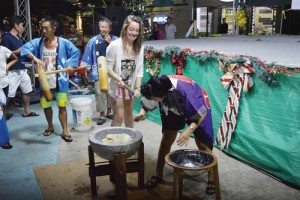Mochitsuki Festival welcomes 2017
A tourist pounds the mochi using a “kine,” a traditional Japanese mallet used for pounding mochi as water in splashed onto the mochi in between pounding to prevent it from sticking to the stone bowl, or “usu.” (Erwin Encinares)

The annual Christmas in the Marianas festival ended with the last scheduled date of the festival celebrating the Japanese traditional New Year festivity, the Mochitsuki Festival, last Dec. 30, 2016.
The festival attracted many tourists of different nationalities: Japanese, American, Chinese, Korean, and even some from Turkey.
“Since the beginning, we noticed [the tourists] coming out, so the performers bring them up on stage to dance and have a good time. On top of all that, we also did weaving demonstrations, which the tourists really got into,” said Marianas Visitors Authority Community Projects specialist Ryan Calvo.
“We are happy to see that kind of interaction [between] our visitors abroad and our local community,” he added.
The Mochitsuki Festival is how the Japanese community welcomes the New Year. It involves the making of traditional mochi, which is pounded day-old sticky rice served with either a sweet stew of red beans known as “oshiruko mochi” or splashed with soy sauce and wrapped in seaweed known as “isobe mochi,” which are both handed out to passers-by during the festival.
According to Hideaki Sawada, owner of Furusato Restaurant, the term mochitsuki was derived from the sticky rice treat, “mochi,” combined with the Japanese expression of hitting, “tsuki.”
The making of mochi was demonstrated during the festival, with festivalgoers being allowed to pound the mochi placed on a large stone bowl known as an “usu,” using the “kine,” a traditional Japanese mallet for pounding the mochi.
According to Sawada, the Japanese eat mochi after New Year and make them before the New Year as an offering to Japanese deities. The mochi is eaten after New Year and symbolizes long life and good fortune for the year ahead.




